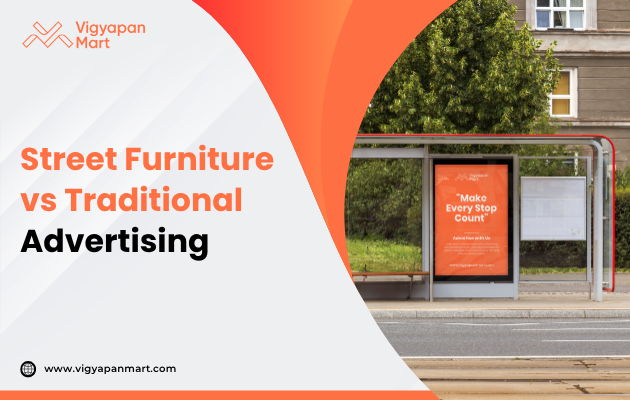Street Furniture vs. Traditional Outdoor Advertising: A Comparative Analysis

Outdoor advertising has long been a staple for brands trying to capture the attention of people on the move. But as cities grow busier and technology transforms public spaces, the competition between street furniture advertising and traditional outdoor advertising like billboards has heated up. In this blog, we’ll break down how these two forms compare, highlighting their key strengths, challenges, and the data behind their impact.
What is Street Furniture Advertising?
Street furniture advertising puts marketing messages on everyday public structures at eye level. Imagine ads on bus shelters, benches, kiosks, and even public trash bins. These ads catch the attention of both pedestrians and drivers as they wait for a bus, walk to school, or stroll through a shopping area.
Key facts
- Common street furniture formats: Bus shelters, benches, kiosks, newsstands, public toilets
- Ads are usually at eye-level, making them hard to miss during daily routines.
What is Traditional Outdoor Advertising?
Traditional outdoor advertising mainly refers to large-scale formats like billboards, posters, and painted signs. They’re usually placed above roads, highways, sports stadiums, or on large building walls.
Key facts
- Billboards are not at eye-level. Drivers see them from a distance, often at high speeds.
- They have historically been the go-to format for mass-market campaigns seeking big, bold visibility.
Visibility & Reach: Where Are People Looking?
Street furniture ads are noticed by people during pauses while waiting at bus stops or resting on benches. This results in higher dwell times, meaning people can engage longer with messages compared to fleeting glances at billboards when driving. The at-eye-level positioning ensures ads are connected to the pedestrian's immediate world. By comparison, billboards are visible from afar and can catch large volumes of vehicle traffic, but the exposure time is much shorter.
Cost-Effectiveness
Street furniture advertising is one of the most cost-effective forms of outdoor marketing.
- The average cost for placing a street furniture, often ranges from under $100 to a few thousand dollars per month, depending on location.
- For transit shelter ads, the average CPM (cost per thousand impressions) is much lower than what you’d pay for TV ads.
- Traditional billboards generally demand higher costs. Large formats can cost thousands per month, and premium locations can skyrocket those numbers.
This affordability makes street furniture ideal for small businesses and local campaigns, not just big brands.
Targeting and Flexibility
Street furniture advertising offers unique targeting:
- Brands can place ads right in neighborhoods where their target audience lives, shops, or commutes.
- This localized approach lets brands plan hyper-local campaigns, perfect for community businesses or events.
- Many street furniture placements also allow for easy campaign updates and creative changes.
Traditional outdoor advertising is better suited for:
- Brand awareness on a large scale, perfect for national chains or major product launches aimed at the masses.
- However, it’s less flexible. Changing billboard ads is slower and sometimes costly.
Engagement and Impact
Street furniture messages blend into daily city life. Because these ads are always present—rain or shine, they build strong brand recognition and even trust among locals.
- They can’t be “skipped” like digital ads.
- Modern street furniture can have digital screens or interactive features, inviting people to engage further (e.g., scanning QR codes).
Billboards still have their place when a brand needs a bold, memorable statement visible for miles. But they’re less interactive and generally don’t offer the community engagement opportunities that street furniture does.
Community Perception
Placing an ad on a public bench or bus shelter also gives a subtle message: Your brand is a part of the community. These public spaces are trusted, and brands advertising in them can benefit from that trust. In contrast, billboards can sometimes be seen as intrusive or cluttering the landscape.
Which Fits Your Needs?
Choose street furniture ads if you want to target specific neighborhoods, maximize dwell time at a low cost, and engage pedestrians with creative messaging. Go for billboard/traditional outdoor if your focus is massive visibility, highway audiences, and high-frequency exposure for major campaigns. Today, many brands combine both, using billboards for bold, widespread awareness, and street furniture to drill down on local engagement and recall.
Conclusion
Street furniture ads cost less and target more precisely, with higher dwell time and daylong visibility. Billboards offer greater reach but less engagement per viewer. Brands are shifting more budget to OOH (out-of-home) options like street furniture as urban populations grow and digital ads get more expensive. Understanding the difference between these formats helps businesses choose the right tool for their brand goals and budgets, making every marketing dollar work harder in today’s crowded world. Are you in need of professional guidance for choosing the right one? We understand that it can be overwhelming so why not connect with a street furniture advertising expert. Yes, connect with Vigyapan Mart and we will help you choose the right one for your requirement and branding.









